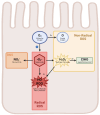Redox Chemistry: Implications for Necrotizing Enterocolitis
- PMID: 39125983
- PMCID: PMC11312856
- DOI: 10.3390/ijms25158416
Redox Chemistry: Implications for Necrotizing Enterocolitis
Abstract
Reduction-oxidation (redox) chemistry plays a vital role in human homeostasis. These reactions play critical roles in energy generation, as part of innate immunity, and in the generation of secondary messengers with various functions such as cell cycle progression or the release of neurotransmitters. Despite this cornerstone role, if left unchecked, the body can overproduce reactive oxygen species (ROS) or reactive nitrogen species (RNS). When these overwhelm endogenous antioxidant systems, oxidative stress (OS) occurs. In neonates, OS has been associated with retinopathy of prematurity (ROP), leukomalacia, and bronchopulmonary dysplasia (BPD). Given its broad spectrum of effects, research has started to examine whether OS plays a role in necrotizing enterocolitis (NEC). In this paper, we will discuss the basics of redox chemistry and how the human body keeps these in check. We will then discuss what happens when these go awry, focusing mostly on NEC in neonates.
Keywords: necrotizing enterocolitis; neonate; oxidative stress; prematurity; reactive nitrogen species; reactive oxygen species.
Conflict of interest statement
The authors declare no conflicts of interest.
Figures


Similar articles
-
Oxidative Stress and Necrotizing Enterocolitis: Pathogenetic Mechanisms, Opportunities for Intervention, and Role of Human Milk.Oxid Med Cell Longev. 2018 Jul 2;2018:7397659. doi: 10.1155/2018/7397659. eCollection 2018. Oxid Med Cell Longev. 2018. PMID: 30057683 Free PMC article. Review.
-
Tumor necrosis factor-alpha and apoptosis signal-regulating kinase 1 control reactive oxygen species release, mitochondrial autophagy, and c-Jun N-terminal kinase/p38 phosphorylation during necrotizing enterocolitis.Oxid Med Cell Longev. 2009 Nov-Dec;2(5):297-306. doi: 10.4161/oxim.2.5.9541. Oxid Med Cell Longev. 2009. PMID: 20716917 Free PMC article.
-
Update on oxygen radical disease in neonatology.Curr Opin Obstet Gynecol. 2001 Apr;13(2):147-53. doi: 10.1097/00001703-200104000-00009. Curr Opin Obstet Gynecol. 2001. PMID: 11315869 Review.
-
FERROPTOSIS AS A NOVEL PATHWAY IN THE PATHOGENESIS OF NECROTIZING ENTEROCOLITIS.Shock. 2025 Jul 1;64(1):12-18. doi: 10.1097/SHK.0000000000002592. Shock. 2025. PMID: 40138732 Review.
-
Inositol in preterm infants at risk for or having respiratory distress syndrome.Cochrane Database Syst Rev. 2019 Jul 8;7(7):CD000366. doi: 10.1002/14651858.CD000366.pub4. Cochrane Database Syst Rev. 2019. PMID: 31283839 Free PMC article.
Cited by
-
Itaconate suppresses neonatal intestinal inflammation via metabolic reprogramming of M1 macrophage.Clin Transl Med. 2025 Jul;15(7):e70419. doi: 10.1002/ctm2.70419. Clin Transl Med. 2025. PMID: 40673634 Free PMC article.
-
Data-independent acquisition-based blood proteomics unveils predictive biomarkers for neonatal necrotizing enterocolitis.Anal Bioanal Chem. 2025 Jan;417(1):199-218. doi: 10.1007/s00216-024-05637-7. Epub 2024 Nov 20. Anal Bioanal Chem. 2025. PMID: 39562369 Free PMC article.
-
Comprehensive Characterization of the Oxidative Stress Profiles in Neonatal Necrotizing Enterocolitis.Int J Med Sci. 2025 Apr 9;22(9):2139-2154. doi: 10.7150/ijms.109008. eCollection 2025. Int J Med Sci. 2025. PMID: 40303487 Free PMC article.
References
-
- Trinci M., Piccolo C.L., Pallottino A.A., Esposito F., Zeccolini M., Miele V. Necrotizing Enterocolitis. In: Miele V., Trinci M., editors. Imaging Non-Traumatic Abdominal Emergencies in Pediatric Patients. Springer International Publishing; Cham, Switzerland: 2016. pp. 53–72.
Publication types
MeSH terms
Substances
LinkOut - more resources
Full Text Sources

